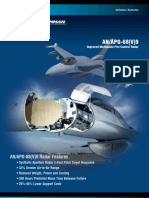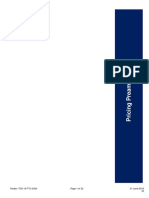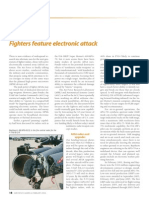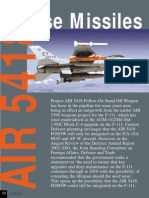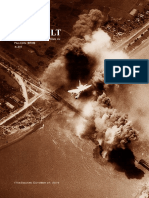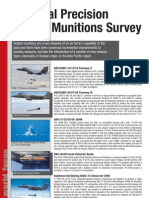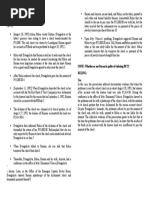Su-30 Vs Raaf Alternatives
Su-30 Vs Raaf Alternatives
Uploaded by
Fakhrul-Razi Abu BakarCopyright:
Available Formats
Su-30 Vs Raaf Alternatives
Su-30 Vs Raaf Alternatives
Uploaded by
Fakhrul-Razi Abu BakarOriginal Title
Copyright
Available Formats
Share this document
Did you find this document useful?
Is this content inappropriate?
Copyright:
Available Formats
Su-30 Vs Raaf Alternatives
Su-30 Vs Raaf Alternatives
Uploaded by
Fakhrul-Razi Abu BakarCopyright:
Available Formats
T E C H N O L O G Y E X P L A I N E D
by Carlo Kopp
Ongoing sales of the Su-30 Flanker family of long range fighters in the region are progressively changing the
strategic landscape. This will have a profound long term impact across the region as the baseline in regional
airpower capabilities rises. Part 2 of this feature explores some of the longer term issues.
Su-30 vs RAAF ALTERNATIVES
Many readers will be asking the obvious question of APG-79 AESA fares much better due to its radar signature
how the Sukhois stack up against the F/A-18A HUG, reduction measures and better radar power aperture perform-
the F-35 JSF and possible interim fighters such as ance, but with external stores its margin of survivability is
the F/A-18E/F. eroded and it is likely to fall well within the engagement enve-
Against all three types the Su-30 derivatives, especially with lope of the Sukhoi and also come to grief (refer radar/missile
later engine subtypes, will always have a significant kinematic plot). A post 2010 AESA equipped Sukhoi could almost cer-
advantage – there is no substitute for thrust in the kinematic tainly take on the F/A-18E with confidence as it will have much
performance game. There is another factor to consider here, better power aperture capability in the radar, enough to offset
which is the superlative 10 tonnes of internal drag free fuel the the radar signature reduction measures in the F/A-18E/F, with
Sukhoi carries. When not operating at extended combat radii, an advanced IRST to supplement radar data.
the Sukhoi driver has more fuel to convert into energy, and that A clean JSF will have the advantage of a very low
energy can nearly always be used to an advantage. Xband radar signature in the forward quarter which will
With mutually competitive WVR missiles and Helmet significantly degrade the Sukhoi’s otherwise overwhelm-
Mounted Sights/Displays for close-in combat, all three ing radar power-aperture advantage over other types.
types will live or die in a close in engagement with an However, the JSF is not designed to be a hot supersonic
advanced Su-30MK variant by pilot ability and good or performer and like the F/A-18s will need to generously
bad luck. The Sukhoi com- use afterburner to effect an
bines high alpha manoeuvre intercept against a rapidly
capabilities with excellent penetrating Sukhoi.
thrust/weight performance, This exposes the JSF to de-
and is apt to have an energy tection and tracking by a
advantage entering and pros- newer technology IRST, and
ecuting a close-in fight. A JSF engagement by long burn
driver opting to engage a heatseeking or optically
thrust vectoring late model guided AAMs such as the R-
Su-30MK in a knife fight may 27ET, R-77T or likely future
not survive to speak of the variants with imaging seekers
experience, unless the Sukhoi analogous to the AIM-9R and
driver is unable to exploit his ASRAAM seekers. With the lat-
advantage properly. ter seekers an R-77/R-77M ac-
In close-in air combat terms quires many of the capabilities
the JSF qualifies as ‘double infe- of the RAAF’s superlative
rior’ against the later model ASRAAM, especially jam resist-
Sukhois, since the Sukhois have ance, but in a long range mis-
an advantage in both thrust/ sile with datalink midcourse
weight ratio and in wing loading guidance. A new two-colour in-
(interested readers refer R.L. frared seeker with 10.8nm
Shaw’s Fighter Combat), and (20km) acquisition range has
with its canard and thrust been announced by the Arse-
vectoring capability will gener- nal infrared systems house, os-
ally be able to gain a firing solu- tensibly for use on the R-77
tion quicker. Because the JSF is series. Professionals might
designed within the kinematic performance class of the F/A-18 contemplate that these are not 1980s 36T series seekers.
and F-16, it is right in the middle of the performance envelope Russia and the Ukraine have a competent infrared sys-
of aircraft the Sukhoi was designed to kill. tems industry – eg Cyclone JSC recently described its QWIP
In Beyond Visual Range (BVR) combat, the Sukhoi will single chip thermal imagers with 128x128 and 320x256 reso-
again have a kinematic advantage, which may be exploitable lution, competitive against the latest EU technology and
at the bounds of engagement radii, as the Sukhoi can gain suitable for missile seekers and thermal imaging IRST detec-
separation in and out of the missile envelope of the F/A-18’s tors. Therefore an advanced derivative of the OLS-30/31 se-
and JSF’s faster – it has the extra thrust and combat fuel to ries with capabilities similar to the Eurofighter PIRATE
play kinematic games both smaller fighters cannot. thermal imaging IRST, but with better detection range, will
The BVR game is however dominated by sensor capabilities, be implementable with Russian hardware in three to five
both onboard and offboard the fighters, and long range missile years given the current rate of evolution.
capabilities. The F/A-18A HUG is wholly outclassed by an Su- In the beam and aft sectors the JSF may also be quite
30MK with an N011M phased array and R-77M ramjet missile. vulnerable to an active or semiactive radar guided missile
A late model F/A-18E with minimal external stores and the shot – its beam and aft sector radar signature reduction is
Australian Aviation September 2003 33
Agat is developing FOG (fibre) gyro technology to avoid
dependency on Western Ring Laser Gyro technology – tran-
sient loss of the JSF radar emission may not defeat the R-
77P/R-77MP – or late model R-27P/EP.
Soviet and more recent Russian BVR doctrine has always
emphasised firing pairs of missiles, one with heatseeking
guidance and one with radar guidance, to defeat counter-
measures. With the option of active radar, heatseeking and
anti-radiation seekers, and by the end of the decade an
imaging seeker, the result is a very lethal cocktail from a
defensive countermeasures perspective – a defending
fighter may only have datalink transmissions to provide
warning and no indication of the seeker mix on the inbound
missiles. With three of the four seeker technologies passive
defeating such weapons is not trivial.
On publicly available data the JSF is likely to be detected
and engaged by an N011M ESA equipped Su-30 inside the 10
to 20nm (19 to 37km) head on range envelope, unless the
JSF can get the first shot off and successfully kill the Su-
khoi. If the Sukhoi can close with the JSF, all bets are off on
the JSF’s ability to survive the close in engagement.
But will the use of the Wedgetail AEW&C to provide
offboard targeting for the JSF provide a decisive advantage
over the Sukhois, will ‘Network Centric Warfare’ offset all
other deficiencies in the force structure and platform capa-
The NIIP N011M phased array is the most capable fighter radar produced bilities? This argument is clearly contingent upon a great
by Russian industry and is designed to support the R-77M family of ramjet many ‘ifs’ – if the Sukhois do not shoot very long range
missiles. The depicted detection range curves are based on publicly dis- missiles at the Wedgetail to force it to shut down or indeed
closed Russian performance figures for co-altitude BVR engagements. It is kill it, if the Wedgetail MESA is not jammed, if the JTIDS/
evident that inside the 10-20 nautical miles envelope the radar will be able
to challenge aircraft with quite good stealth characteristics. The curves for
MIDS or other datalinks to the fighters are not jammed, if
the Agat 9B-1103M and 9B-1348E seekers are based on the most recent the Sukhois are not carrying advanced IRSTs or X-band
Agat data release, and include the TMS320 equipped digital variant. The homing receivers, and if the Sukhois are not supported by
9B-1101K has not been included (Author – NIIP, Phazotron, Agat data). HF or low VHF band radars.
If a JSF were deployed today with a supporting Wedgetail
and existing Su-30 capabilities, then the argument probably
holds most of the time. However, in a post 2010 environment it
much less refined than that in the forward sector. Another is most likely not going to hold up most of the time. If Iraq
factor for the JSF is its radar emission – making it vulner- could acquire smuggled Russian GPS jammers during a UN
able to a long range shot with an anti-radiation seeker arms embargo, there is no guarantee that equipment like high
equipped R-27P, R-27EP, R-77P or when eventually deployed, power L-band jammers, advanced IRST, ESM receivers, long
ramjet R-77MP. While some Low Probability of Intercept range ramjet powered anti-radiation missiles and low band
(LPI) techniques may reduce vulnerability to anti-radiation radars will not proliferate into the region – the Kh-31R has been
missiles, radar modes for closing missile shots typically re- already reported in use with the PLA-AF. Given the mistrust of
quire high update rates and favour the anti-radiation seeker. the US and its allies we see in many regional players, be it the
Since the R-77/R-77M has a midcourse inertial package – PRC or lesser nations, the odds are very good that the existing
Notes: O/B – seeker off-boresight acquisition angle; IRH – heatseeking, single or dual colour scanning seeker; SARH – semi-active radar homing seeker;
DL – datalink for midcourse guidance corrections – either analogue or digital; IMU – inertial package for midcourse guidance; Passive RF – passive radio
frequency anti-radiation seeker; ARH – active radar homing seeker; Acquisition Range is that at which the seeker can acquire its target; Kinematic Range is
A-pole or F-pole; Target G – max load factor of target vehicle; Launch G – max load factor of launch aircraft; APU – Aviatsionnaya Puskovaya Ustanovka
(rail launcher); AKU – Aviatsionnaya Katapultnaya Ustanovka (ejector); This is a current open source compilation based on manufacturers’ and third party
data therefore figures should be treated with appropriate caution (Author).
34 Australian Aviation September 2003
This chart compares some cardinal design
parameters for the Su-30MK series, the JSF
and the F/A-18 family, using manufacturer’s
data. The effective wing loading of the Su-30
is better than depicted, since the aircraft’s
configuration delivers a considerable amount
of body lift. While in the near term the AESAs
in the JSF and F/A-18E/F will be competitive,
in the longer term the retrofit of AESA tech-
nology in the N011M series radar will see the
advantage in power aperture go to the Sukhoi
– both the JSF and F/A-18E/F are aperture
size and cooling capacity limited in growing
AESA performance (Author).
trend will persist and the most advanced Russian hardware, initial Sukhoi aircraft, indeed the Indian government audit
and indigenous equipment, will be widely used. While this will public report lists a litany of contractual problems and
not put a dent into the US Air Force’s stealthy supercruising Su-30K/MK servicabilities as low as 50%. These problems
F/A-22A fleet, it is likely to make life very difficult for the USN should be seen in the proper context as they represent the
with a planned force structure of F/A-18E/Fs and JSFs. If the transient state experienced when introducing a radically
RAAF opts for the JSF as its single type solution it is likely to new piece of technology and supporting systems. The
experience similar grief. Sukhois are a generation beyond the MiG-29s flown by the
In the long term the Russians will find a growing market IAF and two generations ahead of the 1950s technology
for ‘Counter-ISR’ (ISR - Intelligence, Surveillence, Recon- which makes up the backbone of the PLA-AF.
naissance) weapons – the 215nm (398km) KS-172, 160nm With HAL and Shenyang to perform domestic assembly
(296km) R-37 and 60nm (111km) Kh-31 series. In any en- and part production, in time both nations will have the abil-
gagement against a western air force, the first wave of ity to domestically manufacture high failure rate compo-
Sukhois would shoot long range ‘AWACS-killer’ weapons nents, and perform factory/depot deep overhauls. As a result
such as the KS-172, R-37, Kh-31 – or types as yet unknown – what we see now in the support base for the aircraft will not
to either destroy the AEW&C/AWACS or force it to shut persist and should not be used as an indicator of the long
down and retreat – the ‘AWACS-killer’ theme is frequently term supportability of the aircraft. With large fleet sizes even
seen in Russian marketing literature and statements. a large proportion of grounded aircraft still leaves strategi-
The result is that forward defending CAPs have to then cally significant numbers to cause mayhem with.
light up their radars to attempt to function autonomously – Another factor in time will be the availability of third
in turn making them vulnerable to detection by ESM and party Indian and Chinese made spares to other Sukhoi users
shots by anti-radiation missiles like the R-27EP or R-77P/MP. in the region. Bottlenecks in the supply of Russian made
This Russian doctrine of a deluge of long range missiles is spares may not persist past 2010 since the commercial in-
not new – it is a variation on their proven theme of attacking centives to bypass Russian suppliers are considerable – and
naval task forces with long range missiles. It is an evolution- many regional Sukhois will use substantial fractions of
ary adaptation to the growing dependency of western air western avionics hardware. In time we can expect to see
forces on large and vulnerable ISR platforms – the E-3 more bilateral deals, of the ilk seen between India and Ma-
AWACS, RC-135V/W Rivet Joint, E-8 JSTARS, E-10 MC2A and laysia for MiG-29 support, emerging between regional play-
of course the RAAF’s new Wedgetail.
The reality is that of an evolving technological landscape
in which advanced conventional weapons and supporting
technologies proliferate often very rapidly. The rate of Su-30
uptake in the region is a good case study – any nation with
the cash can acquire very quickly large numbers of top-tier
combat aircraft often with the latest western avionics and
Russian weapons and sensors fitted.
STRATEGIC IMPACT OF Su-30 IN THE REGION
We have yet to see the full strategic impact of the Su-30
proliferating in the nearer and wider region. India and China
will not have most of their Sukhoi force structures deployed
until 2015 or later, and it is unclear how many Sukhois both
Malaysia and Indonesia will ultimately operate.
In the near term, both Indonesia and China will have
difficulties with fully exploiting the aircraft as they have
steep learning curves to climb in training and support –
India and Malaysia are apt to fare much better with west-
ern based training systems. We can expect to see regional
users of the Su-30 maturing their capabilities to use the
aircraft in the latter part of this decade. Much has been
said about China’s difficulties in recruiting and training
competent Sukhoi drivers – with a population base of
over a billion it is however only a matter of time before
they learn to do this properly.
Much has been made of the serviceability and support
problems experienced by the IAF and the PLA-AF with their
Australian Aviation September 2003 35
ers and this will change the support environment seen by
smaller regional users of the aircraft.
With four sources of spare component supply rather
than one – Irkut, KNAAPO, HAL and Shenyang lines and
subcontractor pools – market forces will have their im-
pact. To assume that historical case studies of Russian
aircraft support will be representative of the longer term
future in this region is arguably to misunderstand the de-
veloping dynamic across the region. The era of Cold War
technology monopolies is long gone – only the US can
sustain such due to its commanding lead in stealth, pro-
pulsion and computing technologies. This model is not a
valid one for assessing the longer term regional situation
in Russian and third party hardware.
The Su-30s are ‘honest’ 700+ nm (1300+km) radius class
fighters, with plenty of combat gas to burn at shorter radii.
This provides all of the Sukhoi operators with a much larger
air defence footprint than we have ever seen before. India is
now taking delivery of its six Il-78 Midas tankers and will be
able to robustly project its Sukhoi force well beyond its
borders – China has had a long standing interest in tanking
but no firm orders are reported as yet.
Even without a proper tanking capability, lesser regional Recent overseas reports claim the existence of an enhanced variant of
players have the option of buddy refuelling Su-30s with the the Kh-31R, which combines an active radar seeker with passive anti-
UPAZ hose/drogue pod – at the expense of half of the force radiation homing. This weapon is specifically built to kill AEW&C aircraft
committed to tanking sorties. On a buddy refuelling sortie – if the AEW&C aircraft shuts off its radar, the missile switches to active
the shooter gains around 200-250nm (370-464km) of radius – radar terminal homing. The weapon is credited with a standoff range of
yielding a radius very close to 1000nm (1850km). With a around 60 to 100 nautical miles. The Novator KS-172 is a 200+ nautical
200nm (370km) class standoff missile such as a 3M-54E or mile range active radar guided missile, also intended to kill AWACS and
Kh-41 variant, both advertised on Sukhois, this provides a AEW&C aircraft, and promoted on Sukhoi fighters. Such ‘Counter ISR’
limited strike capability beyond a 1000nm (1850km) radius. weapons have evolved in response to overwhelming Western superior-
ity in ISR systems (Author).
While such a strike refuelling technique is not viable for
sustained high intensity operations, it is feasible for nasty
pinprick raids against very high value assets, such as air- further from their runways, and launch limited strikes out to
fields, petrochemical/gas plants, shipping, aircraft carriers around a 1000nm (1850km) radius. While the latter is not the
and other targets, the destruction of which could be highly kind of heavy iron 1000nm (1850km) radius capability Australia
politically embarrassing to the victim. possesses in its F-111 fleet, it is nevertheless enough capability
What this means in practical terms is that Su-30 users will to cause considerable mayhem, if used cleverly.
have the potential to contest airspace up to 500nm (925km) or In the longer term the Sukhoi will have several strategic
effects. The first is that it will provide its users with the
What happens when the existing OLS-27/30/31 series IRST is replaced ability to threaten or intimidate neighbours with lesser capa-
with a newer longwave Focal Plane Array device – such as a single chip bilities, if they fall within the footprint of the Sukhoi. The
QWIP device? The result will be a capability to engage opposing aircraft second is that the US Navy’s carrier battle groups will lose
under clear sky conditions regardless of RCS reduction measures. While much of their ability to intimidate by gunboat diplomacy –
the supercruising F/A-22A can defeat such techniques by kinematics the ability to threaten a CVBG with a mixed package of
alone, fighters in the teen series performance envelope will have to contend shooter and escort Su-27/30s to radii essentially greater than
with BVR shots using the R-27ET, R-77, R-77T and R-77M cued by the that of the F/A-18E/F and JSF mix on a carrier deck drives
thermal imaging search and track set. Similar issues arise with the deploy- up the risk for the US Navy in a nasty political stand-off.
ment of modern ESM receivers on the Su-30MK, analogous to a number
of existing Western systems. The Su-30MK series can then launch long
Unless the US is prepared to take the gloves off early in a
range BVR missiles such as the R-27ET, R-77T with infrared seekers, or the dispute and deploy the F/A-22A centric US Air Force Global
R-27EP and R-77P with passive radio-frequency anti-radiation seekers. If Strike Task Force, the US Navy may cease to be a viable tool
cued by such sensors or offboard sources, these weapons will permit the for coercive diplomacy.
Su-30MK to engage the JSF despite the JSF’s good forward sector radar Even for the US Air Force the Su-30 presents some interest-
stealth performance (Author). ing challenges, since it has the radius to threaten both tankers
and large ISR platforms in a shooting contest. While the
F/A-22A would deal with the Sukhois quickly and effectively, in
many scenarios the Sukhois could create genuine complica-
tions by forcing a relatively high ratio of F/A-22A escort sorties
to F/A-22A strike sorties, thus diminishing the strike sortie rate
– a major issue for the dual role tasked F/A-22A fleet.
Another factor to consider is the ongoing proliferation of
advanced guided munitions and other hardware produced by
competing Russian vendors. Just as we have seen Irkut and
KNAAPO competing in the sales of Sukhois, we have seen a
wide range of Russian weapon makers like Vympel, Zvezda,
Raduga and others selling their products across the accessible
market. Many of these products incorporate modern western
digital COTS technology, an example being the upgraded sec-
ond generation 9B-1103M active radar seeker for the Vympel R-
27A/EA missile, which is built around a Texas Instruments
TMS320C44 digital signal processor chip and achieves a 25%
acquisition range improvement over the baseline seeker, de-
rived from the R-77’s first generation 9B-1348E – a second gen-
36 Australian Aviation September 2003
eration ‘9B-1348ME’ will almost certainly carry the same
TMS320C44 digital signal processor.
Some of the air-surface weapons being offered for the
Sukhois are genuinely capable. The Raduga Kh-41 Moskit
(3M-80/82 SS-N-22 Sunburn) has been integrated on the
Sukhois’ centreline station (refer AA 9/2000) and is consid-
ered to be one of the most lethal supersonic sea skimming
anti-ship weapons in existence. The NPO Soyuz/Turayevo
TKMB ramjet powered Mach 4 class Zvezda-Strela Kh-31
(AS-17 Krypton) is offered on Sukhoi variants, both in the
active radar anti-shipping A model (PLA-N) and anti-radia-
tion R model (PLA-AF). The latest advertised Kh-31 variant
includes a dual mode air-air seeker, incorporating an active
radar seeker and passive anti-radiation seeker, optimised
for engaging ‘non-maneuvering airborne targets such as
AWACS’ out to 100 nautical miles. Both the supersonic
OKB-52 P-800/3K-55/3M-55/Kh-61 Yakhont (SS-N-26) and
Novator 3M-54 Alfa (SS-N-27) have been publicly dis-
cussed as options for the Sukhoi fighters, especially the
Su-34 series, but it is unclear whether any integration
work has taken place to date. analogous to the GBU-15 but 50% bigger, and the
For strikes against land targets, the 1500lb class Molniya KAB-1500Kr a TV contrast lock guided system. Either three
Kh-29 (AS-14 Kedge) is available in television (Kh-29T), ther- of the 1500kg weapons, or six of the 500kg weapons can be
mal imaging contrast lock homing (Kh-29D) and semi-active carried by an Su-27/30 with suitable avionics.
laser homing (Kh-29L) variants – the weapon is a direct To date most regional users have invested in Sukhois pri-
equivalent to the very effective French Aerospatiale AS.30 marily to provide air superiority capabilities. The availability
series, with the television and thermal imaging guided vari- of a wide range of competitively priced Russian guided
ant seeker equivalent to the AGM-65 Maverick series. The weapons is likely to result over time in an increasing broad-
smaller semi-active laser homing S-25LD and Zvezda Kh- ening of the role of regional Sukhoi fleets. The principal
25ML (AS-12 Kegler) are also on offer. An equivalent to the impediment to the wider use of Russian laser guided
RAAF’s AGM-142 is available in the 2000lb class 50nm bombs has been a shortage of good targeting pods – with
(93km) range turbojet sustained Raduga Kh-59M (AS-18 Ka- suitable laser coding modifications third party pods are
zoo), which uses a conceptually similar TV/datalink guid- likely to evolve to fill this niche over the next decade. The
ance scheme, using an APK-9 Tekon datalink guidance pod impact of the US GBU-12 in Afghanistan and Iraq will not
carried on the left inlet pylon. An anti-radiation variant, the have gone unnoticed.
Kh-59 (AS-13 Kingbolt) is available but has not been adver- The television guided KAB-500Kr and KAB-1500Kr kits are
tised on the Sukhoi – the newer Kh-31R series appearing to also worth closer scrutiny, since they provide a fire-and-
be favoured by the market. forget capability very similar to the long retired GBU-8, or a
The Russians are also actively marketing guided bomb GBU-15 used in lock-on-before-launch mode – highly accu-
kits for the Sukhoi fighters. The KAB-500L is a direct equiva- rate and devoid of the need for a targeting pod. With the
lent to the GBU-16 using the 27N series laser seeker, the potential for a pre-programmed scene matching correlation
KAB-500Kr is equivalent to a TV contrast lock guided 1000lb capability (ie pre-loading the bomb with a digitised target
GBU-8 HOBOS fitted with a bunker busting or fuel air explo- image not unlike the early Tomahawk DSMAC), a technol-
sive warhead. The KAB-1500 is a family of guidance kits for ogy the Russians do have, this presents the prospect of a
3000lb class dumb bombs, available with unitary or bunker ‘JDAM-like’ capability to attack multiple aimpoints on a
busting warheads. The KAB-1500L is a semi-active laser single pass, albeit daylight limited. The large volume of
homing kit, the KAB-1500TK a TV command link guided kit the KAB series seekers would easily permit a lot of evolu-
tionary growth in the design, and low cost commodity
processing chips and QWIP thermal imagers would facili-
tate this. It is likely that we will see more of this family of
bomb seekers in time.
Russian sources claim China has ordered the Kh-59ME
standoff missile, the Kh-29T TV guided missile, the Kh-31R
anti-radiation missile, and the KAB-500Kr electro-optically
guided bomb kit. PLA-AF Su-27SKs have been seen carrying
paired KNIRTI L005-S Sorbtsya wingtip jammer pods de-
signed to defeat the APG-63/65/68/70/73 radars and Hawk/
Patriot SAM systems.
CONCLUSIONS
For Australia the Su-30 presents the prospect of a more
difficult to defend sea-air gap. While we might choose to
argue ad nauseam as to whether a future Indonesian regime
might opt to get into a fight with Australia, or debate the
likelihood of PLA-AF Sukhois being based in the northern
approaches at a future date, or debate India’s future role in
the near region, the stark reality is that the tyranny of dis-
tance which has protected Australia for decades is being
rapidly eroded by developing capabilities across the region.
In this context the JSF decision last year, and ongoing
lobbying for F/A-18E/F interim fighters, seem both to be
quite incongruous. Neither aircraft offers a decisive capa-
bility margin against the Su-30 series, especially longer
Australian Aviation September 2003 37
term as the sensors, avionics and weapons evolve in the
Sukhois and regional players possibly acquire AEW&C BOOK REVIEW
aircraft and other supporting capabilities.
Indeed, one idea popular in some Canberra circles seems
to be that the RAAF is now less needed and should be Su-27 Flanker Story
downsized to save money since Indonesia is in a state of
chaos and all the RAAF is needed to do is participate in the byAndrei Fomin
odd US coalition force – of course if anything goes really
bad in our neighbourhood the US will instantly assist! Andrei Fomin’s 300 plus page Su-27 Flanker Story (translated
This is a particularly lame argument insofar as the US Air by Yevgeniy Ozhogin) is by far the best single technical and
Force is already badly stretched with worldwide commit-
historical reference text on Sukhoi’s T-10 family of fighters,
ments, and is having genuine difficulties with a poorly age-
ing tanker and fighter fleet – in a crisis the US may not be in strike fighters and bombers. Making excellent use of access to
the position to deploy sufficient assets quickly enough, even and direct support from the Sukhoi Bureau, KNAAPO, IAPO
if the then incumbent US administration wants to do so. and the Russian Air Force, Fomin’s glossy reference book pro-
There is of course no guarantee that a future US leadership vides a comprehensive insight into the history of the aircraft,
group will have the kind of relationship with Australia
which we observe today. including its early development, and provides often remarkably
The Americans may not solve their block obsolescence detailed descriptions of the various variants and offshoots.
problems until later in the next decade, leaving a genuine With a reference bibliography of 95 titles, 60 colour profiles,
window of strategic vulnerability should the more vocal 18 pages of precise scale line drawings, numerous four page
proponents of RAAF capability reduction have their way
in Canberra. wide foldout illustrations and cutaways, and a plethora of
The belief in some Canberra circles that the JSF will mostly colour photographs, the book is by far the most com-
somehow solve all of the RAAF’s force structure problems plete and detailed open source reference to date. While the
does not stand up to scrutiny, in the light of the known book is a little short on hard technical specifications and detail
capabilities and demonstrated growth potential of the Su- in places, it makes up for this in its sheer breadth and com-
khoi Su-30 which is rapidly becoming the ‘standard’ fighter
across the region. Similarly the belief that interim fighters pleteness of coverage, which includes all variants up to the
will somehow address the capability gap in the F/A-18A Su-30MKI and Su-30MKK, but excluding the Su-30KN.
HUG fleet is hard to accept. The belief that the F-111’s The text includes chapters covering development history,
heavyweight counter-air strike capability is now irrelevant production, navalised variants, the Su-35/37 derivatives, opera-
also conflicts with the reality that the best way to fight an
Su-30 without an F/A-22A is to shut down its basing from tional use, and a chapter surveying air-to-air and air-to-ground
day one of a conflict – and if possible convert the Sukhois to munitions carried by the Flanker family. Fomin’s text should be
scrap metal in situ – neither achievable with a handful of not only of interest to a traditional market of enthusiasts, mod-
standoff missile shots. ellers, and lay observers - it is by any measure a good enough
Strategy has always been a game of positional advantage,
basic reference for defence professionals in this country. This
and in the modern age this positional advantage lies largely
in airpower. If Australia is to retain its relative strategic reviewer can thoroughly recommend this title to any military
position in the region it must start thinking realistically aerospace professional with an interest in regional air power.
about its long term force structure and abandon the quick Su-27 Flanker is published by RA Intervestnik of Moscow,
fix panacea solution mindset which seems to be so promi-
nent in the current Canberra defence debate. There are no www.airfleet.ru.
quick or cheap fixes in this game. ✈ Available from Crusader Trading: 02 6239 2332
9 Townsville Street, Fyshwick ACT 2609
38 Australian Aviation September 2003
You might also like
- Recent Developments in Russian Radar SystemsDocument7 pagesRecent Developments in Russian Radar SystemsDhimas Afihandarin100% (3)
- AN/APG-68 (V) 9 Radar FeaturesDocument5 pagesAN/APG-68 (V) 9 Radar Featuresadrianioantoma100% (2)
- Naval Engineers Journal Volume 109 Issue 1 1997 J. F. McEachron - Subsonic and Supersonic Antiship Missiles - An Effectiveness and Utility ComparisonDocument17 pagesNaval Engineers Journal Volume 109 Issue 1 1997 J. F. McEachron - Subsonic and Supersonic Antiship Missiles - An Effectiveness and Utility ComparisonDhimas Afihandarin100% (2)
- OPP Addendum Charged IndividualsDocument13 pagesOPP Addendum Charged IndividualsNetNewsLedger.comNo ratings yet
- Keller Williams Craig Marks Cma 11 Vacant Land Properties 04272016 Conifer 80433Document21 pagesKeller Williams Craig Marks Cma 11 Vacant Land Properties 04272016 Conifer 80433api-293779854No ratings yet
- Pricing PreambleDocument32 pagesPricing PreambleRyan De Vera PagalNo ratings yet
- Fighters Feature Electronic Attack: AESA Radars and UpgradesDocument4 pagesFighters Feature Electronic Attack: AESA Radars and Upgradesslicendice123No ratings yet
- New Su-30SM2 Will It Be Better Than The RafaleDocument6 pagesNew Su-30SM2 Will It Be Better Than The RafaleHicham Ouakil100% (1)
- Surface To Air Missile SA-10 (S300)Document4 pagesSurface To Air Missile SA-10 (S300)Branislav LackovicNo ratings yet
- Suppression of Enemy Air Defences - Disrupt, Disable, DestroyDocument11 pagesSuppression of Enemy Air Defences - Disrupt, Disable, Destroybring it on100% (1)
- Apg 68Document10 pagesApg 68ninehouyuu67% (3)
- Low Probability of Intercept - RadarDocument4 pagesLow Probability of Intercept - RadarCarlos Eduardo de SouzaNo ratings yet
- Js JC Fa18 Readme A3 v1.9Document12 pagesJs JC Fa18 Readme A3 v1.9Dave91No ratings yet
- Anti Eagle TacticsDocument12 pagesAnti Eagle TacticsAzman Jantan100% (1)
- SA-10 BattalionDocument5 pagesSA-10 BattalionPETR SMITHNo ratings yet
- IRI - FCA Part 2Document26 pagesIRI - FCA Part 2Sanel KapetanovicNo ratings yet
- S 300VDocument49 pagesS 300VSohail SafeerNo ratings yet
- After JF-17 Fighter, Chinese J-11B Jet Could Be Next On Pakistan's Shopping List (Analysis)Document4 pagesAfter JF-17 Fighter, Chinese J-11B Jet Could Be Next On Pakistan's Shopping List (Analysis)turandotNo ratings yet
- Low Band Aquisition RadarsDocument67 pagesLow Band Aquisition Radarsserrorys100% (1)
- Sukhoi - KnAAPO Su-35BM - Su-35-1 - Su-35S FlankerDocument28 pagesSukhoi - KnAAPO Su-35BM - Su-35-1 - Su-35S Flankercos2in100% (1)
- PLA Air Defence RadarsDocument67 pagesPLA Air Defence RadarsYacine Khlil100% (2)
- DT Alcm Aug 04 P 3Document4 pagesDT Alcm Aug 04 P 3Dinh LeNo ratings yet
- The Vault TeeSquare 2019-10-27Document53 pagesThe Vault TeeSquare 2019-10-27pina100% (1)
- Phazotron Zhuk AE/ASE: Assessing Russia's First Fighter AESADocument22 pagesPhazotron Zhuk AE/ASE: Assessing Russia's First Fighter AESAkab115121803100% (1)
- Long 1985Document11 pagesLong 1985Đinh Ngọc Việt Tùng100% (1)
- Active Electronically Scanned Array (AESA) Fire Control RadarsDocument2 pagesActive Electronically Scanned Array (AESA) Fire Control Radarsمحمد على100% (1)
- 19 AF PricopMihaiVictor, BoscoianuMircea, NaeCatalin, CojocaruMariusGabrielDocument10 pages19 AF PricopMihaiVictor, BoscoianuMircea, NaeCatalin, CojocaruMariusGabrielKIRU SILVIUNo ratings yet
- MissilDocument10 pagesMissiletorreblanca75No ratings yet
- Sample Meb2Document4 pagesSample Meb2PaleoMiłekNo ratings yet
- F16 Wideband Military Radomes Fact SheetDocument2 pagesF16 Wideband Military Radomes Fact SheetKang HsiehNo ratings yet
- Aim-120 Amraam: Advanced Medium Range Air-to-Air MissileDocument10 pagesAim-120 Amraam: Advanced Medium Range Air-to-Air MissileA RozzNo ratings yet
- BMS Threat GuideDocument67 pagesBMS Threat GuideWachi SonNo ratings yet
- MissilesDocument4 pagesMissilesargonautabizarroNo ratings yet
- Kuchinski 1984Document8 pagesKuchinski 1984Đinh Ngọc Việt TùngNo ratings yet
- Ea-6b Global SecurityDocument14 pagesEa-6b Global SecuritydemontisNo ratings yet
- Catalogue MissilesDocument8 pagesCatalogue Missilesyounes-spirit100% (6)
- Strike Tutorial - 5 NotesDocument6 pagesStrike Tutorial - 5 NotesWilliam néronNo ratings yet
- Air ArmamentDocument29 pagesAir ArmamentAmit Kumar100% (2)
- 1988 - 2821 PDFDocument1 page1988 - 2821 PDFتپل خستهNo ratings yet
- NIIP 2K12 Kub/Kvadrat Self Propelled Air Defence System / SA-6 Gainful НИИП Cамоходный Зенитный Ракетный Комплекс 2К12 Куб/ КвадратDocument23 pagesNIIP 2K12 Kub/Kvadrat Self Propelled Air Defence System / SA-6 Gainful НИИП Cамоходный Зенитный Ракетный Комплекс 2К12 Куб/ КвадратMarcus Wolf100% (1)
- TF23 KAANEnglishDocument25 pagesTF23 KAANEnglishAnas MirzaNo ratings yet
- 2023-iran-airdefense-systems-table-POL3813Document1 page2023-iran-airdefense-systems-table-POL3813Anton MihailovNo ratings yet
- Flanker Radars in Beyond Visual Range Air CombatDocument57 pagesFlanker Radars in Beyond Visual Range Air CombathailemeamanuelNo ratings yet
- Russian AIDocument5 pagesRussian AIkab11512No ratings yet
- aprile2008Document5 pagesaprile2008ndh17012003No ratings yet
- GAME CHANGER Spy-6 Radar Raytheon Missiles & Defense Breaking DefenseDocument3 pagesGAME CHANGER Spy-6 Radar Raytheon Missiles & Defense Breaking DefenseSam OyelowoNo ratings yet
- F-16 Radar Computer For The APG-66 Pulse Doppler RadarDocument8 pagesF-16 Radar Computer For The APG-66 Pulse Doppler Radarmetroplex_cl100% (1)
- F-16 Wide Band RadomeDocument2 pagesF-16 Wide Band RadomebioineNo ratings yet
- SA-5 BattalionDocument5 pagesSA-5 BattalionPETR SMITHNo ratings yet
- Distributed Electronic WarfareDocument2 pagesDistributed Electronic Warfarebring it onNo ratings yet
- APG-83 Vs APG-80Document8 pagesAPG-83 Vs APG-80David Vương100% (2)
- DCS ReferenceGuide v28CDocument169 pagesDCS ReferenceGuide v28CMaverik100% (1)
- Bae PDF Eis FotdDocument6 pagesBae PDF Eis FotdFırat KarataşNo ratings yet
- Design and Implementation of Ground Station Antennas For UAV Data Radio Link in UHF BandDocument6 pagesDesign and Implementation of Ground Station Antennas For UAV Data Radio Link in UHF BandNicolas BuitragoNo ratings yet
- Active Model Rocket Stabilization Via Cold Gas Thrusters - Danylo MalyutaDocument12 pagesActive Model Rocket Stabilization Via Cold Gas Thrusters - Danylo MalyutaTim MarvinNo ratings yet
- AAM EvolutionDocument4 pagesAAM EvolutionManuel Solis100% (1)
- 2.7 SAR HazonDocument26 pages2.7 SAR HazonthemaxiumNo ratings yet
- Davisday 1Document24 pagesDavisday 1Anonymous mw6kqFgNo ratings yet
- BAe Active Skyflash and AIM-120 AMRAAMDocument11 pagesBAe Active Skyflash and AIM-120 AMRAAMYacine KhlilNo ratings yet
- APG66Document8 pagesAPG66green_equation100% (1)
- A-10 Thunderbolt II Units of Operation Enduring Freedom 2002-07From EverandA-10 Thunderbolt II Units of Operation Enduring Freedom 2002-07No ratings yet
- Gowind 2500 Designed For CombatDocument4 pagesGowind 2500 Designed For CombatFakhrul-Razi Abu BakarNo ratings yet
- Advanced F-18 Super Hornet PDFDocument21 pagesAdvanced F-18 Super Hornet PDFFakhrul-Razi Abu BakarNo ratings yet
- Golden Chresonese PDFDocument40 pagesGolden Chresonese PDFFakhrul-Razi Abu BakarNo ratings yet
- Hegemon Print PDFDocument18 pagesHegemon Print PDFFakhrul-Razi Abu BakarNo ratings yet
- Tutorial 1Document4 pagesTutorial 1Nikhil VermaNo ratings yet
- Army Institute of Law: Court Diary SubmissionDocument11 pagesArmy Institute of Law: Court Diary Submissionakash tiwariNo ratings yet
- PDF Kajaria Report Final - CompressDocument40 pagesPDF Kajaria Report Final - CompressMd Borhan Uddin 2035097660No ratings yet
- Branch News: Rawngbawl T Ur A ChhandamDocument4 pagesBranch News: Rawngbawl T Ur A ChhandamktpchaltlangNo ratings yet
- Industrial Organizational PsychologyDocument22 pagesIndustrial Organizational Psychologyannekerstine50No ratings yet
- CSC110 Lecture 02 HandoutsDocument14 pagesCSC110 Lecture 02 HandoutsMuhammad Tahir MehmoodNo ratings yet
- Manact1 Variable Costing RecitDocument75 pagesManact1 Variable Costing RecitRica Jane ContrerasNo ratings yet
- Module 1 - Introduction To Consumption TaxesDocument3 pagesModule 1 - Introduction To Consumption TaxesMonica MonicaNo ratings yet
- NECYPAA Outreach CalendarDocument3 pagesNECYPAA Outreach CalendarMatt KostandinNo ratings yet
- Bilcans Grammar WorldDocument250 pagesBilcans Grammar WorldSyed M. WaqasNo ratings yet
- CD - Bayani VS PeopleDocument1 pageCD - Bayani VS PeopleAb RilNo ratings yet
- Export & Import DocumentationDocument7 pagesExport & Import DocumentationOnkar Chavan100% (1)
- 14 Fun Facts About Greece You Never Knew Real WordDocument1 page14 Fun Facts About Greece You Never Knew Real WordKarl JuurikasNo ratings yet
- Elementary Vocabulary - Part 1Document1 pageElementary Vocabulary - Part 1Andres Felipe PalenciaNo ratings yet
- IR Notes On NEGOTIATION 101Document14 pagesIR Notes On NEGOTIATION 101Mallhar MohapatraNo ratings yet
- Proforma Invoice Lmt4-40-BocDocument2 pagesProforma Invoice Lmt4-40-BocLoreen MtangaraNo ratings yet
- Gambia Value ChainDocument81 pagesGambia Value ChainAnn PulidoNo ratings yet
- READING Choosing The Right Social Media PlatformsDocument29 pagesREADING Choosing The Right Social Media PlatformsHadi RazaNo ratings yet
- Worksheet CHN 1Document13 pagesWorksheet CHN 1CoxnxkNo ratings yet
- Al AdwanDocument29 pagesAl Adwanlem123anNo ratings yet
- Impact of Workforce Diversity On Employees' Performance in Nigeria Public Service A Study of Rivers State Civil Service, 2010 2017Document9 pagesImpact of Workforce Diversity On Employees' Performance in Nigeria Public Service A Study of Rivers State Civil Service, 2010 2017Editor IJTSRDNo ratings yet
- Paul O'Neill. The Wrong Place: Rethinking Context in Contemporary ArtDocument5 pagesPaul O'Neill. The Wrong Place: Rethinking Context in Contemporary ArtMuladarNo ratings yet
- Zionist Media Domination:: The Jewish Suicide Bomber Thatt You Never Heard OffDocument9 pagesZionist Media Domination:: The Jewish Suicide Bomber Thatt You Never Heard OffResearchingPub0% (1)
- Assignment No.1Document6 pagesAssignment No.1Aaquib AleemNo ratings yet
- Western Education Is Better Than African education-SBKDocument4 pagesWestern Education Is Better Than African education-SBKB Sheku KoromaNo ratings yet
- Silencing Caste, Sanitising Oppression: Understanding Swachh Bharat AbhiyanDocument7 pagesSilencing Caste, Sanitising Oppression: Understanding Swachh Bharat Abhiyanneha sharmaNo ratings yet
- Curriculum VitaeDocument1 pageCurriculum VitaeMuadz FaridNo ratings yet

